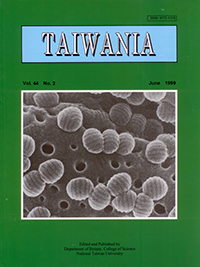Research Paper
Exine Development in Borago (Boraginaceae)2. Free Microspore Stages.
John R. Rowley, John J. Skvarla and Nina I. Gabarayeva
Published on: June 1999
Page: 212 - 229
DOI: 10.6165/tai.1999.44(2).212
Abstract
At the beginning of the free microspore period, when the callosic special cell wall is digested, darkly contrasted particles appear distally on each of the columellae. They are 15 to 20 nm in diameter and are connected to each other like beads on a string. Several of such 'strings' form a bouquet-like formation on the distal end of columellae. We consider these particles to be involved with sporopollenin accumulation and refer to them as sporopollenin acceptor particles (SAPs). SAPs appear to be associated with an increase in height of columellae and formation of gemmae. By the end of exine development columellar height has increased 2 to 3 times. In mature pollen gemmae have rounded ridges on their surface that are the same size as SAPs in the late microspore stage.
中文摘要
在自由孢子初期,當特殊的胼胝壁溶解時,每柱狀層遠軸面末端出現強對比的顆粒。它們直徑為15至20nm,且像一串念珠互相連接在一起。數串念珠構成一個花束狀出現在柱狀層遠軸面末端。我們認為這些顆粒和孢粉寧質的堆積有關,且將它們歸類為孢粉寧質接受顆粒。孢粉寧質接受顆粒的出現伴隨著柱狀層的高度成長和棒狀物的形成。在花粉外壁發育末期柱狀層高度增長為2至3倍。在自由孢子晚期,成熟花粉棒狀物表面有圓型隆起且和孢粉寧質接受顆粒大小相同。 關鍵字:玻璃苣屬,柱狀層,花粉外壁,棒狀物,孢子,孢粉寧質接受顆粒。
Keyword: Borago, Columellae, Exine, Gemmae, Microspores, Sporopollenin acceptor particles (SAPs).


